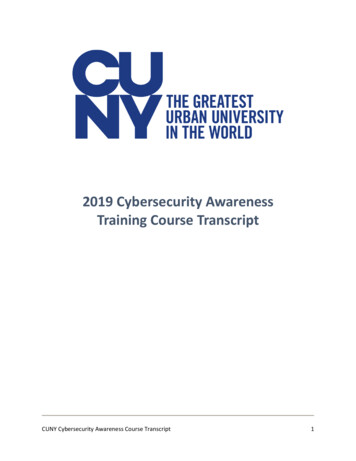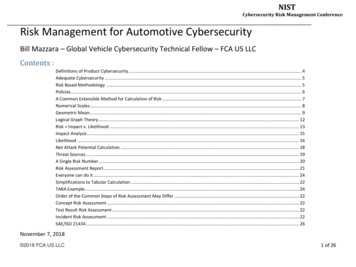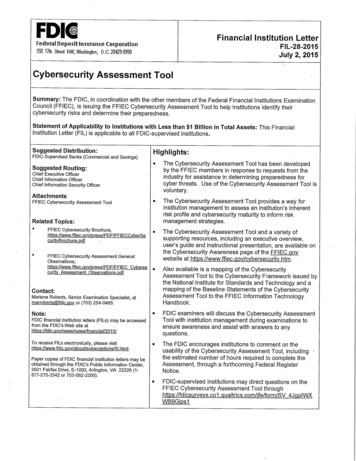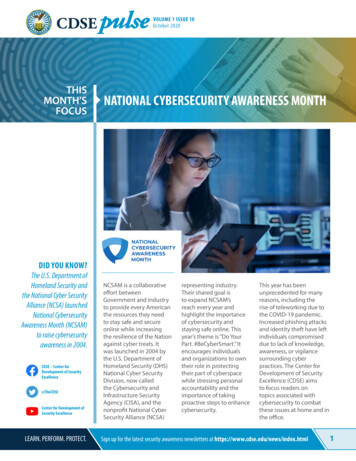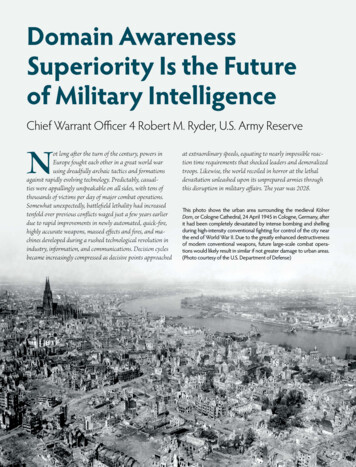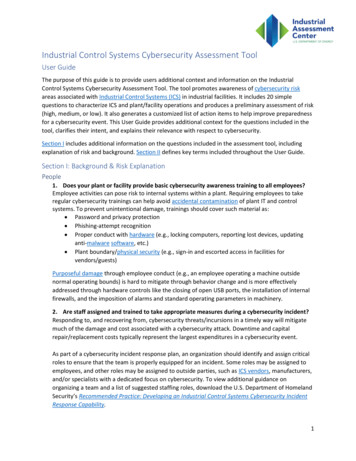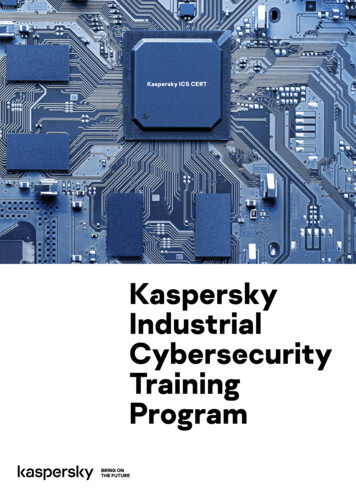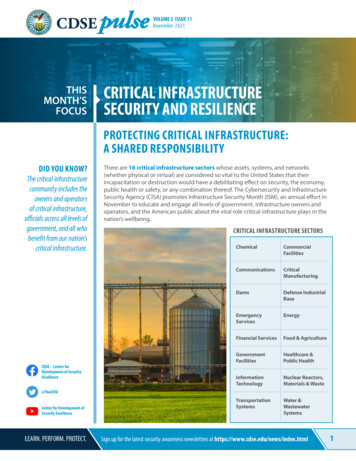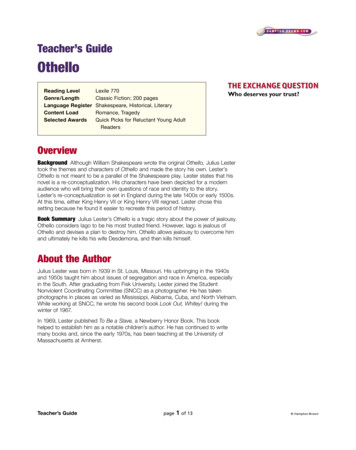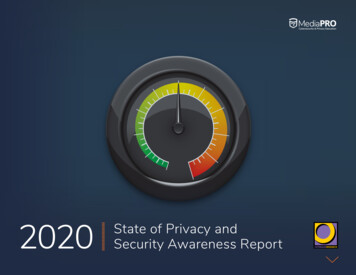
Transcription
Conceptualization of a CyberSecurity AwarenessQuizSebastian Pape1,2 [0000 0002 0893 7856] , Ludger Goeke1 , AlejandroQuintanar1 , and Kristian Beckers112Social Engineering Academy (SEA) GmbHEschersheimer Landstrasse 42, 60322 Frankfurt am Main, GermanyGoethe University Frankfurt, Faculty of Economics and Business AdministrationTheodor-W.-Adorno-Platz 4, 60323 Frankfurt am Main, GermanyAbstract. Recent approaches to raise security awareness have improveda lot in terms of user-friendliness and user engagement. However, sincesocial engineering attacks on employees are evolving fast, new variantsarise very rapidly. To deal with recent changes, our serious game CyberSecurity Awareness Quiz provides a quiz on recent variants to makeemployees aware of new attacks or attack variants in an entertainingway. While the gameplay of a quiz is more or less generic, the core ofour contribution is a concept to create questions and answers based oncurrent affairs and attacks observed in the wild.Keywords: Serious game · CyberSecurity Awareness · Human factor1IntroductionSocial engineering attacks represent a continuing threat to employees of organizations. With a wide availability of different tools and information sources [5],it is a challenging task to keep up to date of recent attacks on employees sincenew attacks are being developed and modifications of known attack scenariosare emerging. The latest Data Breach Investigations Report [2] reports anotherincrease of financially motivated social engineering, where the attacker directlyask for some money, i. e. by impersonating CEOs or other high-level executives.However, during the writing of the report, scammers have already varied theirapproach and also ask for purchase and transfer of online gift cards1 in order toscam employees. Additionally, scammers also base attacks on the current newssituation, such as COVID-19 Ransomware [15]. While a couple of defense methods and counteracting training methods [16, 17] exist, at present, most of themcan not be adapted fast enough to cope with this amount and speed of newvariations.The CyberSecurity Awareness Quiz is a serious game in form of an onlinequiz to raise the security awareness of employees, in particular against social engineering attacks. The game follows the approach that quiz questions are 265112535040
2S. Pape et al.on real-world social engineering attacks. Additionally, the pool of questions willconstantly be extended by new questions in relation to current social engineeringattacks. For this purpose, a specific process for the procurement of appropriateinformation is developed, which is described in detail in Section 3.2. Our contribution within this paper is the conceptualization of the CyberSecurity AwarenessQuiz with a focus on the concept how to generate questions for the quiz gamebased on current affairs and attacks observed in the wild.The remainder of the paper is structured as follows: Sect. 2 lists some relatedgames, explains the relationship of the CyberSecurity Awareness Quiz withpreviously developed games and how it integrates into a more general trainingplatform. Its concept is explained in Sect. 3 along with the planned componentsin Sect. 4. We conclude in Sect. 5.2Background and Related WorkThere is a large number of tabletop games for security training or awarenessraising [6, 8, 4, 3, 14] targeting different domains, asset and areas in the academia.However, the ones which are closer to CyberSecurity Awareness Quiz aremostly commercial without a detailed description. Nevertheless, we give a briefoverview of them in the following. The “Emergynt Risk Deck” highlights ITsecurity risks to business leadership [7]. “OWASP Snakes and Ladders” is aneducational game to raise security awareness about application security controlsand risks [13]. Within the game “Quer durch die Sicherheit” players move towards the target by answering questions correctly [10]. “Stadt Land HACK!” isa quiz about data privacy and security [11].Since the above mentioned games are all tabletop or card games, they cannot be adapted to recent security incidents easily. While there is only a limitedvariation of different variants of a quiz-style game, our main contribution of thisconceptual paper is the process for the creation of questions along with the ideato mostly use the CyberSecurity Awareness Quiz to keep users informed aboutrecent attacks in an entertaining way.2.1Relation to Existing GamesNaturally, the aim and scope of a game can not be too broad. Similar to securityawareness campaigns [1], serious games also benefit from an adaption to the userand his/her specific needs. Therefore, CyberSecurity Awareness Quiz is part ofa series of games dovetailed to a chain aiming at raising security awareness (cf.Fig. 1). For security requirements engineering, employees are playing HATCH [3],in order to identify relevant attacks and develop countermeasures. All identifiedthreats which can not be technically addressed, need to be integrated into theorganisation’s security policy. Once the security policy is developed or updated,employees can train to apply it and get an understanding how it addresses certain attacks by playing PROTECT [9]. However, naturally different attacks orvariations of attacks will sprout faster than the security policies can be adapted.
Conceptualization of a CyberSecurity Awareness Quiz3Fig. 1. The Relation of HATCH [3], PROTECT [9] and CyberSecurity AwarenessQuizThus, CyberSecurity Awareness Quiz is used to raise awareness about the latest attacks and their variations, based on the player’s general understandingdeveloped in the game sessions of HATCH and PROTECT.2.2Embedding into a CyberSecurity Training PlatformBesides the use and interplay of CyberSecurity Awareness Quiz with otherserious games, it is also important to integrate them into a more general trainingplatform, such as the THREAT-ARREST [12] advanced training platform (cf.Fig. 2).Fig. 2. The THREAT-ARREST Advanced Training Platform [12]
4S. Pape et al.This way it is not only possible to train employees during their use of theserious games, but also to embed and manage their efforts in a broader way.The result of CyberSecurity Awareness Quiz sessions contribute to THREATARREST’s continuous evaluation of the individual trainees’ performance and theeffectiveness of the training programs. Within the platform for each trainee results of the serious games, the emulation, the simulation and the training toolare brought together to spot possible gaps in the employee’s knowledge or awareness. If knowledge gaps are identified, it can be checked if there already existsa training on the specific topic as serious game, simulation or emulation of thecyber range system. If no appropriate training can be identified, this might indicate the need of producing a new training, tailored to the organizational needsand the trainee types.3ConceptThe fast change and adaption of attacks as sketched in the introduction showthe necessity for employees to keep their knowledge about social engineeringup-to-date.Since we expect only a reasonable amount of new attacks or attack variations,we decided to aim for a lightweight game with the idea that it could be playedoccasionally (e. g. when traveling in trams or subways). In general, the gameshould be playable alone since this avoids any necessity to find or wait for otherplayers, but in particular for long term motivation, comparisons with or gamesagainst other players should be possible. In summary, we identified the followingrequirements:––––3.1Questions refer to recent real-world threatsLightweightPlayable on mobile devicesSingle and multi-player modesGame ConceptOne game type which fulfills the requirements is a quiz game, where playershave to answer a set of questions. In CyberSecurity Awareness Quiz, a questiondescribes a certain social engineering attack scenario which is based on a recentattack observed in the real world in an abstract and general way. For everyquestion, the possible answers contain one or more correct answers and one ormore incorrect answers. Correct answers will represent consequences which resultfrom the attack that is described in the question. Accordingly, incorrect answerswill represent effects which can not result from the attack. A mockup of theplanned GUI which also shows a sample question is illustrated in Fig. 3.CyberSecurity Awareness Quiz will provide different modes in which a quizcan be played. Either by a single player or in competition between two players.These modes are described in the following:
Conceptualization of a CyberSecurity Awareness Quiz5Fig. 3. Mockup of the User Interface along with a Sample QuestionSingle Quiz: A player will answer the questions of a quiz alone.Context Quiz: Single-player quiz with specific questions depending on thepreferences of a player. Examples for specific questions are scenarios concerning a certain location, industry sector or role/position in the company.Furthermore, it is possible to play only recent added questions, e. g. questionsadded in the last 3 months.Versus Quiz: Two players will compete in a quiz against each other. A questionwill be asked simultaneously to both players. The player who will answer aquestion correctly gets a point. If both players are correct, the faster playerwins. The player who will answer more questions correctly, wins the quizround.Pick Quiz: In this mode, two players will answer questions one after the other.Here, the player who has answered his/her last question correctly choosesthe next question for the opponent out of different options until the opponent answers a question correctly. If this is the case, the right for choosingquestions changes and so on. Only the first question will be asked to bothplayers simultaneously. The player who answers this question correctly firstwill have the right to choose the next question for the opponent.Draw Quiz: This mode will have the same rules as the Pick Quiz mode withthe following modification: Instead of choosing the next question out of dif-
6S. Pape et al.ferent options, the player who has answered his/her last question correctlywill choose the industry/sector to which the next question for the opponentrelates.For the the modes context quiz, pick quiz and draw quiz, certain metadata onthe scenarios is needed. Therefore, question will be tagged by predefined types ofmetadata. This metadata will enable a categorization of questions which allowsit to combine questions to different quizzes for certain training objectives orspecific groups of players. For example, a specific set of questions will be ableto reference a certain type of attacks (e. g. different forms of phishing), industrysector (e. g. energy suppliers), department (e. g. human resources), a geographicarea (e .g. Europe) or all new attacks added after a given date. The possibility ofadapting a quiz to the players needs aims to enable players to map the mediatedlearning content directly to their work routine.Additionally, the metadata will enable an on the fly compilation of the questions for a quiz round played in the Context Quiz mode. Here, the player providesinformation which refers to certain aspects of social engineering he/she wantsto be considered in the next quiz round. This quiz round will include all thepredefined questions which are tagged with metadata that matches the providedinformation.We describe the different types of metadata used in Sect. 3.2.3.2Process for Information Procurement and Question GenerationA key feature of CyberSecurity Awareness Quiz will be the fact that its questions are based on real-life attacks whereby the amount of questions will bepermanently expended to cover new social engineering attacks. To fulfill thisrequirement, an appropriate process for gathering content regarding attacks andthe creation of corresponding questions and answers is needed. This process issketched in Fig. 4.The first step of the process includes the procurement of information withrespect to current social engineering attacks. While the number of relevant attacks might be feasible, there is a huge amount of reports of attacks, privacybreaches, data losses, etc. Due to the high frequency in which they occur as wellas the multitude of information sources, the information procurement presentsan enormous challenge. To meet this challenge, the information procurement willinclude automated tasks which are discussed later in this section.The second step of the process for the creation of questions and answersincludes the formulation of questions for a quiz. Usually, questions will be createdbased on content about social engineering attacks which has been collected inStep 1. If this is the case, the game content designer will check for a new relevantweb feed first if a corresponding question already exists. For this check he/shewill filter the existing questions by the types of metadata which are relevant forthe new web feed.In the third step, a created question will be tagged with metadata. Thismetadata will represent characteristics of an attack like the category of an attack
Conceptualization of a CyberSecurity Awareness QuizInputContent about realworld attacks fromweb resourcesActivity1. Reviewof attackcontentOutputRelevant attackcontentRelevant attackcontentQuestionfor attackPredefinedtypes of metainformation2. Formulationof questionfor attack3. Assignmentof metainformation toquestionQuestion forattackQuestion for attackwith metainformationExistingCORRECTanswers4. Selection/refinement/creation ingINCORRECTanswers5. Selection/refinement/creation g. 4. Process for the Creation of Questions and Answers for Social Engineering Attacks(e. g. phishing). CyberSecurity Awareness Quiz will provide predefined typesof metadata, which are specified in Tab. 1. This table includes the name of ametadata type and its description. The metadata of questions is important forthe reuse of questions during the creation of certain predefined quizzes and thecompilation of on the fly quizzes within the Context Quiz mode (see Section 3.1).As discussed in the previous section, metadata allows to filter questions by specialcategories when creating a quiz with a certain topic. For example, if a quizshall refer to attacks which are targeting employees of the human resourcesdepartment, questions whose metadata parameter of the type Department hasthe value ”human resources” should be assessed for consideration. The sameconcept is applied when a quiz round is played in the Context Quiz mode. Here,the player provides information regarding his/her preferences and the startedquiz comprises only such questions whose metadata corresponds to the providedinformation. For example, if a player is interested in all types of new phishingattacks from a certain point in time, he/she can selects the value ”phishing”for the metadata type Attack category and the value ”from 01.06.2020” for themetadata type Time of attack.In the fourth step of the process correct answers are assigned to a question.In this context, new correct answers can be created or already existing correctanswers can be reused.The last step of the process includes the assignment of incorrect answersto a question. As for correct answers, incorrect answers can be newly created oralready existing incorrect answers can be reused.Information Procurement One objective of the information procurement isto gather content related to social engineering attacks which is published on appropriate web resources like news websites, websites about information security,websites of institutions, blogs or even twitter. In this context, in particular websites which provide information about their new content in a structured manner
8S. Pape et al.(e. g. web feeds) will be considered. Figure 5 shows an overview of the steps forthe information procurement.Game contenteditor1. Research for appropriateweb feed services7. Assess web feed6. Review of original content5. Notify for new content2. Subscribeto relevantweb feedsWebsites3. Pull new webfeedsFeedAggregator4. Notify fornew contentContentManagerWeb feedsAssessment web feedContent CollectorFig. 5. Tasks for Gathering and Analysing Content about AttacksWeb feeds present a form of pull data. This means, that users can requestfrequently information in relation to new content on subscribed websites byusing appropriate tools (e. g. feedreaders). Web feeds are machine-readable fileswhich are provided in standardized formats like RSS2 or Atom3 . They includedata which addresses among others the title and a short description of the newcontent, the URL of the original resource, the publishing date and the name ofthe author.As Fig. 5 illustrates, some tasks for the information procurement need to beperformed manually by the game content editor. Other steps will be performedautomatically by a component of CyberSecurity Awareness Quiz which is namedContent Collector. The different steps of the process for information procurementare explained in the following.In the initial step of the process, the game content editor will search for websites which publish content about social engineering attacks and implement aweb feed service. This step will be repeated periodically to check if new appropriate web resources are available. In the second step, the game content editor23depending on the version RSS means: RDF Site Summary or Really Simple SyndicationAtom Syndication Format is an XML language used for web feeds
Conceptualization of a CyberSecurity Awareness Quiz9will subscribe to the found web feed services by using the Feed Aggregator whichis a subcomponent of the Content Collector. The Feed Aggregator will query automatically and periodically the subscribed websites for new web feeds (step 3).If new web feeds have been found, it will notify the Content Manager (step 4)which is another subcomponent of the Content Collector. The Content Manager, which is responsible for the management of gathered web feeds, will informthe game content editor that new content is available (step 5). Then, the gamecontent editor will review the original content of the corresponding web feed(step 6). Afterwards he/she will assess in the Content Manager if the content tothe web feed is relevant or not (step 7).Web feeds which will be marked as relevant can be used for the formulationof new quiz questions (see Figure 4, step 2).Types of Metadata As already discussed, questions need to be tagged bymetadata in order to allow the categorization of questions during the creationof predefined quizzes and within on the fly compilation of quizzes with respectto the Context Quiz mode (see Section 3.1). The different types of metadataare specified in Tab. 1. Additionally, (correct and incorrect) answers will be alsotagged with metadata (cf. Tab. 2). The Multiplicity will specify the number ofdata items which have to be assigned at least and can be assigned at most.Table 1: Types of Metadata for Tagging of QuestionsType of metadataTitleType of attackexecutionDescriptionMultiplicityTitle of an attack1Specification if an attack is executed (i) directly on 1site by an attacker (e.g. an attacker tries to get access to a secured server room by pretending to be aservice technician), (ii) indirectly by using a technical medium (e.g. phishing via email) or (iii) differentcombinations of direct and/or indirect executions.Attack category Categories which typify an attack (e.g. vishing). In 1.*this connection, an attack can be assigned to exactlyone category or to several categories. For example,an attack which uses dumpster diving can only beassociated to the category dumpster diving. An attack in which emails with malicious links are sent toCEOs can be assigned to the categories email fraud,phishing, email phishing and whaling.Type of at- Typing of the attacker who executes an attack 1.*tacker(e.g. cyber criminal, fraudster, intelligence service,hacker).
10S. Pape et al.Type of meta- DescriptiondataFeigned identity Defines the identity of the entity/person which/whois feigned by the attacker during an attack. Regarding enterprises or institutions, a feigned identitycould refer to internal persons like colleagues, C-levelpersonnel and employees from other branches or external persons like customers, technicians and cleaning stuff. In the private context, an attacker couldpretend to be a relative, friend or a person who seeksfor help. When feigning an entity, an attacker couldpretend to be an employee of a state authority (e.g.tax authority) or a private institute (e.g. banks).Context of vic- Specifies the context(s) of the victims who are tartimsgeted by an attack. For this parameter the valuesindividual and organisation are predefined.Characteristics Specifies the characteristic(s) for a group of victimsofprivate in person of individual who are threatened by anvictim4attack. For individuals this could be demographiccharacteristics (e.g. age, gender, interests, internetusage).Sector5Specifies the sector/industry of organisations whichare threatened by an attack (e.g. energy suppliers,financial institutes, state institutions).Department5Defines certain departments of an organisation (e.g.human resources, finance, IT) which are affected byan attack.Role5Indicates certain roles of employees of an organisation (e.g. CEO, administrator, financial accountant)which are threatened by an attack.Motivation for Specifies the motivation for the execution of anattackattack (e.g. espionage, criminal intend, interest inhacking ).ObjectiveDefines the objective of an attack (e.g illegal fidescriptionnancial transactions, gaining of sensitive information/data, identity theft).Exploited psy- Psychological pattern which is tried to be exploitedchological pat- by an attack (e.g. authority, good faith, laziness).ternUsed technol- Technology which has been used during the attackogy(e.g. email for phishing or telephone for 0.*CONDITION: This parameter is only used when the parameter Context of victimshas the value individualCONDITION: This parameter is only used when the parameter Context of victimshas the value organisation
Conceptualization of a CyberSecurity Awareness Quiz11CyberSecurity Awareness Quizquery configurationStart nagerQuiz ManageruseuseQuiz GamePlayersNotify regardingnew contentGamecontenteditorContentCollectorFig. 6. Components of CyberSecurity Awareness QuizType of meta- DescriptiondataGeographicalThe geographical area where the attack has beenspreadingconducted (e.g. worldwide, Europe, United States,California, Milan).Time of attack Period(s) of time in which the attack has been conducted.SourcesSources of the content on which the attack bases.Multiplicity1.*1.*1.*Table 2: Types of Metadata for Tagging of AnswersType of meta- DescriptiondataAttack category Specifies the attack category or rather different attack categories of questions to which an answer couldbe assigned.Answer typeIndicates if an answer is correct or incorrect in thecontext of its attack categories.4Multiplicity1.*1Architecture and ComponentsThis section discusses the different components of CyberSecurity AwarenessQuiz which will implement the concepts described in Sect. 3. Figure 6 providesan overview of these components and the rudimentary communication betweenthem. Additional, it shows the different roles which will use certain components.For the sake of clarity, a representation of the database and the correspondingcommunication between the database and components has been omitted.
12S. Pape et al.CyberSecurity Awareness QuizQuiz ManagerDatabaseQuiz Pool EditorQuizpooluseGamecontenteditorQuestion Pool EditorQuestionpoolAnswerpoolAnswer Pool EditorFig. 7. Editors provided by the Quiz Manager4.1Content CollectorWe have already introduced the Content Collector in Section 3.2, thus the following description is limited to the essentials.The Content Collector will provide functionality for the collection of newcontent about social engineering attacks in the form web feeds. To this, it willcheck the subscribed web feed services frequently for new content.A further functionality of the Content Collector will enable the managementof collected web feeds. It will inform the game content designer when new contenthas been collected and will allow to assign his/her assessments regarding itsrelevance to the related web feeds. If a web feed will be considered as relevant bythe game content editor, the Content Collector will notify another component inform of the Quiz Manager (see Section 4.2) that new relevant content is available.The content collector will be exclusively used by the game content editor.4.2Quiz ManagerThe Quiz Manager will enable the game content editor to manage (i) the pool ofavailable quizzes and the separate (ii) pool of questions and (iii) pool of answers.For that purpose, the Quiz Manager will implement corresponding editors namedQuiz Pool Editor, Question Pool Editor and Answer Pool Editor. These differenteditors, which are represented in Figure 7, are discussed in the following.The Question Pool Editor will enable the creation of questions which areadded to the question pool (cf. Fig. 7) and the specification of the correspondingmetadata. In general, the questions are based on content that has been collected
Conceptualization of a CyberSecurity Awareness Quiz13Fig. 8. Mockup of the User Interface of the Quiz Pool Editorby the Content Collector (see Section 4.1). Additionally, the Question Pool Editor will allow the editing of questions in the pool and their deletion.In the context of creating or editing a question, the Question Pool Editor willalso implement the assignment of correct and incorrect answers to a question.For that purpose, it will supply a dialogue for the creation of new answers andthe related metadata. When the input is finalized, a created answer will be addedto the answer pool (cf. Fig. 7).The Question Pool Editor will also display a list of existing answers from theanswer pool which could be relevant for the current question because of theirassigned attack categories. Besides adding new answers, it will be possible toassign any existing answer to the edited question.With respect to the management of the answer pool (cf. Fig. 7), the AnswerPool Editor will implement the creation of new answers and the related metadataas well as the editing and deletion of answers.The functionality of creating new quizzes and adding them to the pool ofavailable quizzes (cf. Fig. 7) will be implemented by the Quiz Pool Editor (cf.Fig. 8). In the mockup of the user interface of the Quiz Pool Editor it is shownthat every quiz has a title and is identified by an unique identifier.It will be possible to reuse predefined questions from the question pool for anew quiz. For that purpose, the Quiz Pool Editor will display a list of predefinedquestions from the question pool which can be filtered by the metadata of thequestions. This way, the game content designer will be able to restrict the numberof displayed questions.During the creation of a quiz, the Quiz Pool Editor will also allow the creationof new questions and the related answers. A newly created question will be addedadditionally to the question pool, when it is finalized. If newly created answerswill be assigned to a created question, these answers will be also added to the
14S. Pape et al.Fig. 9. Mockup of the User Interface of the Add Question Dialogue of the Quiz PoolManageranswer pool. Figure 9 shows the dialogue for adding existing questions to a quiz.Here, the set of displayed questions corresponds to the selected filter parameters.Functionalities for the editing and deletion of quizzes will also be suppliedby the Quiz Pool Editor.4.3Provision ManagerThe Provision Manager facilitates configurations with respect to provisions ofCyberSecurity Awareness Quiz. These configurations will be managed by thegame content editor. The different configuration parameters are represented inTab. 3.Table 3. Configuration Parameters for the Provisioning of CyberSecurity AwarenessQuizConfiguration pa- DescriptionrameterAvailable quizzesSpecifies the quizzes which shall be available for the player tobe played.Activated modesIndicates which single-player modes and/or multi-player modesshall be activated within a provision.4.4Start ScreenWhen a player will start the CyberSecurity Awareness Quiz client, the StartScreen will appear. Depending on the configuration provided by the Provison
Conceptualization of a CyberSecurity Awareness Quiz15Manager, the Start Screen will show which gaming modes are activated andwhich quizzes can be played.The Start Screen acts as a frontend of CyberSecurity Awareness Quiz tostart games in the component Quiz Game (see Section 4.5) with one of theactivated quizzes. If the player plays a game in the Context Quiz mode (seeSection 3), he/she will be able to provide the information which determines howthe content of the quiz to be played will be compiled.If any multi-player mode is activated, the Start Screen will display otherplayers which are currently online. Accordingly, a player will be able to arrangea game in one of the multi-player modes with an available competitor.4.5Quiz GameThe component Quiz Game will implement the actual quiz game. A certain quizgame can be invoked by the Start Screen (see Section 4.4). For that purpose,the Start Screen will pass the required parameters for a quiz to the Quiz Game.These parameters will include among other information, the set of questions andthe mode in which the quiz will be played.The graphical user interface (GUI) of the Quiz Game will differ depending onthe gaming mode in which the quiz is played. A mockup was alre
Similar to security awareness campaigns [1], serious games also bene t from an adaption to the user and his/her speci c needs. Therefore, CyberSecurity Awareness Quiz is part of a series of games dovetailed to a chain aiming at raising security awareness (cf. Fig. 1). For security requirements engineering, employees are playing HATCH [3],
